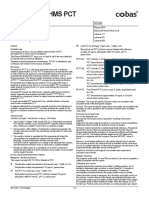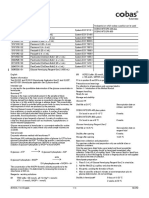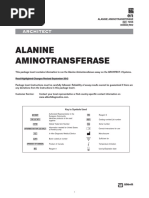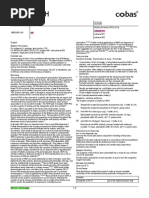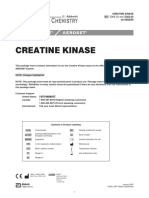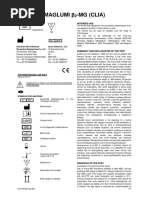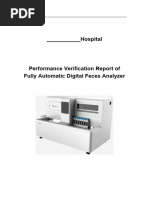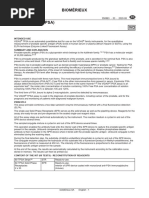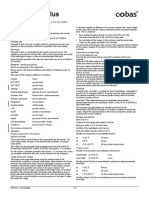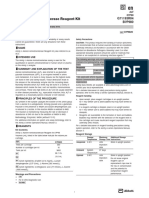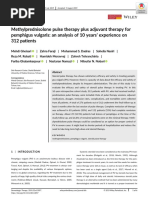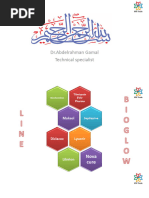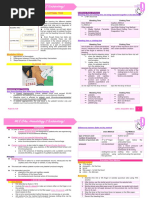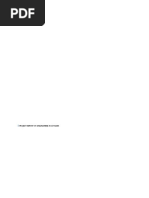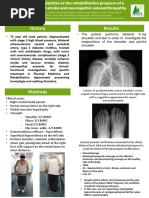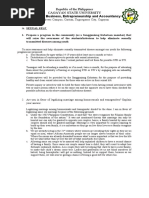ALB2
ALB2
Uploaded by
Jonalyn SalandoCopyright:
Available Formats
ALB2
ALB2
Uploaded by
Jonalyn SalandoCopyright
Available Formats
Share this document
Did you find this document useful?
Is this content inappropriate?
Copyright:
Available Formats
ALB2
ALB2
Uploaded by
Jonalyn SalandoCopyright:
Available Formats
0003183688122c501V10.
ALB2
Albumin Gen.2
Order information
Analyzer(s) on which cobas c pack(s) can be used
03183688 122 Albumin Gen.2 300 tests System‑ID 07 6592 9 Roche/Hitachi cobas c 311, cobas c 501/502
10759350 190 Calibrator f.a.s. (12 x 3 mL) Code 401
10759350 360 Calibrator f.a.s. (12 x 3 mL, for USA) Code 401
12149435 122 Precinorm U plus (10 x 3 mL) Code 300
12149435 160 Precinorm U plus (10 x 3 mL, for USA) Code 300
12149443 122 Precipath U plus (10 x 3 mL) Code 301
12149443 160 Precipath U plus (10 x 3 mL, for USA) Code 301
10171743 122 Precinorm U (20 x 5 mL) Code 300
10171735 122 Precinorm U (4 x 5 mL) Code 300
10171778 122 Precipath U (20 x 5 mL) Code 301
10171760 122 Precipath U (4 x 5 mL) Code 301
05117003 190 PreciControl ClinChem Multi 1 (20 x 5 mL) Code 391
05947626 190 PreciControl ClinChem Multi 1 (4 x 5 mL) Code 391
05947626 160 PreciControl ClinChem Multi 1 (4 x 5 mL, for USA) Code 391
05117216 190 PreciControl ClinChem Multi 2 (20 x 5 mL) Code 392
05947774 190 PreciControl ClinChem Multi 2 (4 x 5 mL) Code 392
05947774 160 PreciControl ClinChem Multi 2 (4 x 5 mL, for USA) Code 392
04489357 190 Diluent NaCl 9 % (50 mL) System‑ID 07 6869 3
English The color intensity of the blue‑green color is directly proportional to the
albumin concentration in the sample and is measured photometrically.
System information
For cobas c 311/501 analyzers: Reagents - working solutions
ALB2: ACN 413 R1 Citrate buffer: 95 mmol/L, pH 4.1; preservatives, stabilizers
For cobas c 502 analyzer: R2 Citrate buffer: 95 mmol/L, pH 4.1; bromcresol green: 0.66 mmol/L;
ALB2: ACN 8413 preservatives, stabilizers
Intended use R1 is in position B and R2 is in position C.
In vitro test for the quantitative determination of albumin in human serum
and plasma on Roche/Hitachi cobas c systems. Precautions and warnings
Summary1,2 For in vitro diagnostic use.
Exercise the normal precautions required for handling all laboratory
Albumin is a carbohydrate‑free protein, which constitutes 55‑65 % of total reagents.
plasma protein. It maintains plasma oncotic pressure, and is also involved Disposal of all waste material should be in accordance with local guidelines.
in the transport and storage of a wide variety of ligands and is a source of Safety data sheet available for professional user on request.
endogenous amino acids. Albumin binds and solubilizes various
compounds, e.g. bilirubin, calcium and long‑chain fatty acids. Furthermore, For USA: For prescription use only.
albumin is capable of binding toxic heavy metal ions as well as numerous Reagent handling
pharmaceuticals, which is the reason why lower albumin concentrations in Ready for use
blood have a significant effect on pharmacokinetics.
Hyperalbuminemia is of little diagnostic significance except in the case of Storage and stability
dehydration. Hypoalbuminemia occurs during many illnesses and is caused ALB2
by several factors: compromised synthesis due either to liver disease or as
a consequence of reduced protein uptake; elevated catabolism due to Shelf life at 15‑25 °C: See expiration date
tissue damage (severe burns) or inflammation; malabsorption of amino on cobas c pack
acids (Crohn’s disease); proteinuria as a consequence of nephrotic label.
syndrome; protein loss via the stool (neoplastic disease). In severe cases of
hypoalbuminemia, the maximum albumin concentration of plasma is On‑board in use and refrigerated on the analyzer: 12 weeks
2.5 g/dL (380 µmol/L). Due to the low osmotic pressure of the plasma, Diluent NaCl 9 %
water permeates through blood capillaries into tissue (edema). The
determination of albumin allows monitoring of a controlled patient dietary Shelf life at 2‑8 °C: See expiration date
supplementation and serves also as an excellent test of liver function. on cobas c pack
Test principle3 label.
Colorimetric assay On‑board in use and refrigerated on the analyzer: 12 weeks
At a pH value of 4.1, albumin displays a sufficiently cationic character to be
able to bind with bromcresol green (BCG), an anionic dye, to form a Specimen collection and preparation
blue‑green complex. For specimen collection and preparation only use suitable tubes or
collection containers.
Only the specimens listed below were tested and found acceptable.
Serum.
pH 4.1
Plasma: Li‑heparin and K2‑EDTA plasma
Albumin + BCG albumin‑BCG complex Do not use fluoride plasma.
2015-03, V 10.0 English 1/4
0003183688122c501V10.0
ALB2
Albumin Gen.2
The sample types listed were tested with a selection of sample collection Decreased 2 µL 35 µL 70 µL
tubes that were commercially available at the time of testing, i.e. not all
available tubes of all manufacturers were tested. Sample collection systems Increased 2 µL – –
from various manufacturers may contain differing materials which could
affect the test results in some cases. When processing samples in primary cobas c 502 test definition
tubes (sample collection systems), follow the instructions of the tube Assay type 2‑Point End
manufacturer.
Reaction time / Assay 10 / 10‑14
Centrifuge samples containing precipitates before performing the assay.
points
Stability:4 2.5 months at 20‑25 °C Wavelength (sub/main) 505/570 nm
5 months at 4‑8 °C Reaction direction Increase
4 months at -20 °C Units g/L (µmol/L, g/dL)
Materials provided Reagent pipetting Diluent (H2O)
See “Reagents – working solutions” section for reagents. R1 100 µL –
Materials required (but not provided) R2 20 µL 30 µL
▪ See “Order information” section
▪ General laboratory equipment
Sample volumes Sample Sample dilution
Assay
For optimum performance of the assay follow the directions given in this Sample Diluent (NaCl)
document for the analyzer concerned. Refer to the appropriate operator’s Normal 2 µL – –
manual for analyzer‑specific assay instructions.
Decreased 2 µL 35 µL 70 µL
The performance of applications not validated by Roche is not warranted
and must be defined by the user. Increased 4 µL – –
Application for serum and plasma Calibration
cobas c 311 test definition Calibrators S1: H2O
Assay type 2‑Point End S2: C.f.a.s.
Reaction time / Assay 10 / 6‑9 Calibration mode Linear
points
Calibration frequency 2‑point calibration
Wavelength (sub/main) 505/570 nm • after 4 weeks on board
Reaction direction Increase • after reagent lot change
• as required following quality control
Units g/L (µmol/L, g/dL)
procedures
Reagent pipetting Diluent (H2O)
Traceability: This method has been standardized against the reference
R1 100 µL – preparation of the IRMM (Institute for Reference Materials and
R2 20 µL 30 µL Measurements) BCR470/CRM470 (RPPHS ‑ Reference Preparation for
Proteins in Human Serum).5
Quality control
Sample volumes Sample Sample dilution For quality control, use control materials as listed in the "Order information"
Sample Diluent (NaCl) section.
In addition, other suitable control material can be used.
Normal 2 µL – –
The control intervals and limits should be adapted to each laboratory’s
Decreased 2 µL 35 µL 70 µL individual requirements. Values obtained should fall within the defined
Increased 2 µL – – limits. Each laboratory should establish corrective measures to be taken if
values fall outside the defined limits.
cobas c 501 test definition Follow the applicable government regulations and local guidelines for
quality control.
Assay type 2‑Point End
Calculation
Reaction time / Assay 10 / 10‑14
Roche/Hitachi cobas c systems automatically calculate the analyte
points concentration of each sample.
Wavelength (sub/main) 505/570 nm
Conversion factors: g/L x 15.2 = µmol/L
Reaction direction Increase
µmol/L x 0.0658 = g/L
Units g/L (µmol/L, g/dL)
g/L x 0.1 = g/dL
Reagent pipetting Diluent (H2O)
Limitations - interference
R1 100 µL –
Criterion: Recovery within ± 10 % of initial values at an albumin
R2 20 µL 30 µL concentration of 35 g/L (532 µmol/L).
Icterus:6 No significant interference up to an I index of 60 for conjugated
and unconjugated bilirubin (approximate conjugated and unconjugated
Sample volumes Sample Sample dilution bilirubin concentration: 1026 μmol/L or 60 mg/dL).
Sample Diluent (NaCl) Hemolysis:6 No significant interference up to an H index of 1000
Normal 2 µL – – (approximate hemoglobin concentration: 621 µmol/L or 1000 mg/dL).
2/4 2015-03, V 10.0 English
0003183688122c501V10.0
ALB2
Albumin Gen.2
Lipemia (Intralipid):6 No significant interference up to an L index of 550. Precision
There is poor correlation between the L index (corresponds to turbidity) and Precision was determined using human samples and controls in an internal
triglycerides concentration. protocol with repeatability (n = 21) and intermediate precision (3 aliquots
Drugs: No interference was found at therapeutic concentrations using per run, 1 run per day, 21 days).The following results were obtained:
common drug panels.7,8
Repeatability Mean SD CV
In very rare cases, gammopathy, in particular type IgM (Waldenström’s
macroglobulinemia), may cause unreliable results.9 g/L (µmol/L, g/dL) g/L (µmol/L, g/dL) %
For diagnostic purposes, the results should always be assessed in
conjunction with the patient’s medical history, clinical examination and other Precinorm U 32.4 (492, 3.24) 0.3 (5, 0.03) 1.1
findings. Precipath U 32.1 (488, 3.21) 0.3 (5, 0.03) 1.1
Colorimetric methods used for the determination of Albumin may lead to
falsely elevated test results in patients suffering from renal failure or Human serum 1 51.3 (780, 5.13) 0.4 (6, 0.04) 0.7
insufficiency due to interference with other proteins. Immunoturbidimetric Human serum 2 42.4 (644, 4.24) 0.5 (8, 0.05) 1.2
methods are less affected.
ACTION REQUIRED Intermediate precision Mean SD CV
Special Wash Programming: The use of special wash steps is mandatory
when certain test combinations are run together on Roche/Hitachi g/L (µmol/L, g/dL) g/L (µmol/L, g/dL) %
cobas c systems. The latest version of the carry‑over evasion list can be
found with the NaOHD/SMS/Multiclean/SCCS or the Precinorm U 32.6 (496, 3.26) 0.5 (8, 0.05) 1.5
NaOHD/SMS/SmpCln1+2/SCCS Method Sheets. For further instructions Precipath U 32.0 (486, 3.20) 0.5 (8, 0.05) 1.5
refer to the operator’s manual. cobas c 502 analyzer: All special wash
programming necessary for avoiding carry‑over is available via the Human serum 3 51.3 (780, 5.13) 0.5 (8, 0.05) 0.9
cobas link, manual input is not required. Human serum 4 42.2 (641, 4.22) 0.4 (6, 0.04) 1.0
Where required, special wash/carry‑over evasion programming must
be implemented prior to reporting results with this test. Method comparison
Albumin values for human serum and plasma samples obtained on a
Limits and ranges Roche/Hitachi cobas c 501 analyzer (y) were compared with those
Measuring range determined using the corresponding reagent on a
2‑60 g/L (30.4‑912 µmol/L, 0.2‑6 g/dL) Roche/Hitachi 917 analyzer (x).
Determine samples having higher concentrations via the rerun function. Sample size (n) = 150
Dilution of samples via the rerun function is a 1:3 dilution. Results from
samples diluted using the rerun function are automatically multiplied by a Passing/Bablok13 Linear regression
factor of 3. y = 1.025x - 0.129 g/L y = 1.021x + 0.009 g/L
Lower limits of measurement τ = 0.930 r = 0.997
Lower detection limit of the test
The sample concentrations were between 17.2 and 58.9 g/L (261 and
2 g/L (30.4 µmol/L, 0.2 g/dL) 895 µmol/L).
The lower detection limit represents the lowest measurable analyte level
that can be distinguished from zero. It is calculated as the value lying References
3 standard deviations above that of the lowest standard (standard 1 + 3 SD, 1 Grant GH, Silverman LM, Christenson RH. Amino acids and proteins.
repeatability, n = 21). In: Tietz NW, ed. Fundamentals of Clinical Chemistry, 3rd edition
Philadelphia, PA: WB Saunders 1987:328-330.
Expected values
2 Marshall WJ, ed. Illustrated Textbook of Clinical Chemistry, 3rd ed.
Reference Range Study10 London: Gower Medical Publishing 1989;207-218.
Adults 3.97‑4.94 g/dL 39.7‑49.4 g/L 603‑751 µmol/L 3 Doumas BT, Watson WA, Biggs HG. Albumin standards and the
measurement of serum albumin with bromcresol green. Clin Chim Acta
1971;31:87-96.
Consensus Values11 4 Use of Anticoagulants in Diagnostic Laboratory Investigations. WHO
Adults 3.5‑5.2 g/dL 35‑52 g/L 532‑790 µmol/L Publication WHO/DIL/LAB/99.1 Rev. 2. Jan. 2002.
5 Baudner S, Bienvenu J, Blirup-Jensen S, et al. The certification of a
matrix reference material for immunochemical measurement of
Reference Intervals according to Tietz12 14 human serum proteins CRM470. Report EUR 15243 EN
1993;1-186.
Newborn
6 Glick MR, Ryder KW, Jackson SA. Graphical Comparisons of
0‑4 days 2.8‑4.4 g/dL 28‑44 g/L 426‑669 µmol/L Interferences in Clinical Chemistry Instrumentation. Clin Chem
Children 1986;32:470-475.
7 Breuer J. Report on the Symposium “Drug effects in Clinical Chemistry
4 days‑14 years 3.8‑5.4 g/dL 38‑54 g/L 578‑821 µmol/L Methods”. Eur J Clin Chem Clin Biochem 1996;34:385-386.
14‑18 years 3.2‑4.5 g/dL 32‑45 g/L 486‑684 µmol/L 8 Sonntag O, Scholer A. Drug interference in clinical chemistry:
Each laboratory should investigate the transferability of the expected values recommendation of drugs and their concentrations to be used in drug
to its own patient population and if necessary determine its own reference interference studies. Ann Clin Biochem 2001;38:376-385.
ranges. 9 Bakker AJ, Mücke M. Gammopathy interference in clinical chemistry
Roche has not evaluated reference ranges in a pediatric population. assays: mechanisms, detection and prevention.
Clin Chem Lab Med 2007;45(9):1240-1243.
Specific performance data
10 Junge W, Bossert-Reuther S, Klein G, et al. Reference Range Study for
Representative performance data on the analyzers are given below. Serum Albumin using different methods. Clin Chem Lab Med (June
Results obtained in individual laboratories may differ. 2007 Poster EUROMEDLAB) 2007;45 Suppl:194.
2015-03, V 10.0 English 3/4
0003183688122c501V10.0
ALB2
Albumin Gen.2
11 Dati F, Schumann G, Thomas L, et al. Consensus of a group of
professional societies and diagnostic companies on guidelines for
interim reference ranges for 14 proteins in serum based on the
standardization against the IFCC/BCR/CAP reference material (CRM
470). Eur J Clin Chem Clin Biochem 1996;34:517-520.
12 Burtis CA, Ashwood ER, Bruns DE, eds. Tietz Textbook of Clinical
Chemistry and Molecular Diagnostics, 4th ed Philadelphia, PA: WB
Saunders 2006;549.
13 Bablok W, Passing H, Bender R, et al. A general regression procedure
for method transformation. Application of linear regression procedures
for method comparison studies in clinical chemistry, Part III. J Clin
Chem Clin Biochem 1988 Nov;26(11):783-790.
A point (period/stop) is always used in this Method Sheet as the decimal
separator to mark the border between the integral and the fractional parts of
a decimal numeral. Separators for thousands are not used.
Symbols
Roche Diagnostics uses the following symbols and signs in addition to
those listed in the ISO 15223‑1 standard.
Contents of kit
Volume after reconstitution or mixing
GTIN Global Trade Item Number
FOR US CUSTOMERS ONLY: LIMITED WARRANTY
Roche Diagnostics warrants that this product will meet the specifications
stated in the labeling when used in accordance with such labeling and will
be free from defects in material and workmanship until the expiration date
printed on the label. THIS LIMITED WARRANTY IS IN LIEU OF ANY
OTHER WARRANTY, EXPRESS OR IMPLIED, INCLUDING ANY IMPLIED
WARRANTY OF MERCHANTABILITY OR FITNESS FOR PARTICULAR
PURPOSE. IN NO EVENT SHALL ROCHE DIAGNOSTICS BE LIABLE
FOR INCIDENTAL, INDIRECT, SPECIAL OR CONSEQUENTIAL
DAMAGES.
COBAS, COBAS C, PRECINORM, PRECIPATH and PRECICONTROL are trademarks of Roche.
All other product names and trademarks are the property of their respective owners.
Significant additions or changes are indicated by a change bar in the margin.
© 2014, Roche Diagnostics
Roche Diagnostics GmbH, Sandhofer Strasse 116, D-68305 Mannheim
www.roche.com
Distribution in USA by:
Roche Diagnostics, Indianapolis, IN
US Customer Technical Support 1-800-428-2336
4/4 2015-03, V 10.0 English
You might also like
- Labureader Plus 2: Semi-Automated Urine Chemistry AnalyzerDocument2 pagesLabureader Plus 2: Semi-Automated Urine Chemistry AnalyzerCARLOSNo ratings yet
- Insert CRPL3 0004956842190c501 V8 enDocument4 pagesInsert CRPL3 0004956842190c501 V8 enAnonymous F50PFE3No ratings yet
- CreaDocument5 pagesCreaKouame Francis0% (1)
- CalciumDocument5 pagesCalciumDrAlaa ZidanNo ratings yet
- 20110503CK CobasDocument8 pages20110503CK CobashermesNo ratings yet
- ALPDocument4 pagesALPRastu KaryanaNo ratings yet
- RANDOXDocument18 pagesRANDOXAbigaile PaulinoNo ratings yet
- Cholesterol ARC CHEMDocument8 pagesCholesterol ARC CHEMSalah AnamNo ratings yet
- VB12 Reagent KitDocument7 pagesVB12 Reagent Kitaymanepocket0% (1)
- Elecsys BRAHMS PCT: ProcalcitoninDocument5 pagesElecsys BRAHMS PCT: ProcalcitoninDóra BenczeNo ratings yet
- CYSC2Document4 pagesCYSC2ARIF AHAMMED PNo ratings yet
- Sgot Roche c111Document4 pagesSgot Roche c111Harditya FirdhausNo ratings yet
- GLLUDocument4 pagesGLLUARIF AHAMMED PNo ratings yet
- Insert TRIGL 0020767107322COIN V11 enDocument4 pagesInsert TRIGL 0020767107322COIN V11 entechlabNo ratings yet
- Free PSADocument4 pagesFree PSANIGHT tubeNo ratings yet
- DIALAB ProductRange 2017 Rev01 v2 2017 02 21Document40 pagesDIALAB ProductRange 2017 Rev01 v2 2017 02 21Khaled0% (1)
- CSAIIDocument5 pagesCSAIIARIF AHAMMED PNo ratings yet
- CA 0100 CH 2 X 50 ML CA 0500 CH 4 X 125 ML: LinearityDocument1 pageCA 0100 CH 2 X 50 ML CA 0500 CH 4 X 125 ML: LinearityDharmesh PatelNo ratings yet
- A UricDocument8 pagesA UricmichelNo ratings yet
- ALT Insert ReagentDocument8 pagesALT Insert ReagentcydolusNo ratings yet
- 01 Glucose G71245R04Document7 pages01 Glucose G71245R04chem.rajavithiNo ratings yet
- Insert - Elecsys Syphilis - Ms 07802960190.V3.EnDocument5 pagesInsert - Elecsys Syphilis - Ms 07802960190.V3.EnGuneyden GuneydenNo ratings yet
- 10 Calcium G71246R02 07P57Document6 pages10 Calcium G71246R02 07P57chem.rajavithiNo ratings yet
- 120 17 Oh Progesterone en Eu v9.2Document6 pages120 17 Oh Progesterone en Eu v9.2Laboratoire Dr Mansouri Reghaia Alger100% (1)
- Insert HDLC4 0208057877190c503 V3 enDocument4 pagesInsert HDLC4 0208057877190c503 V3 enRaj KumarNo ratings yet
- L0027404900 Top - 300-350 - SM - OptDocument1,276 pagesL0027404900 Top - 300-350 - SM - Optalean.gomez100% (1)
- AlakalinePhos ARC CHEMDocument8 pagesAlakalinePhos ARC CHEMTanveerNo ratings yet
- Access 2 Immunoassay System BrochureDocument4 pagesAccess 2 Immunoassay System BrochureSenyum Sehat100% (1)
- Elecsys AMH: 06331076 190 Cobas e 411 Cobas e 601 Cobas e 602 English System InformationDocument6 pagesElecsys AMH: 06331076 190 Cobas e 411 Cobas e 601 Cobas e 602 English System InformationAbdullah ZobayerNo ratings yet
- CEA 11973223001 - enDocument3 pagesCEA 11973223001 - enModestusNo ratings yet
- AAGP2 enDocument3 pagesAAGP2 enLince WijoyoNo ratings yet
- Finecare Parameters 20191211Document8 pagesFinecare Parameters 20191211Hân NguyễnNo ratings yet
- Creatine Kinase: 7D63-20 and 7D63-30Document8 pagesCreatine Kinase: 7D63-20 and 7D63-30ابكر ابو ميلادNo ratings yet
- Competitive Evaluation of The GEM Premier 3000 With PDFDocument8 pagesCompetitive Evaluation of The GEM Premier 3000 With PDFEllya Latifah IlyasNo ratings yet
- Ft3 IflashDocument4 pagesFt3 IflashNIGHT tube100% (1)
- Normal Control 1 - 0020013900: ENGLISH - Insert Revision 04/2018Document3 pagesNormal Control 1 - 0020013900: ENGLISH - Insert Revision 04/2018Brady AndersonNo ratings yet
- H-046-003256-00 TPSA KIT (CLIA) Muti LaguageDocument14 pagesH-046-003256-00 TPSA KIT (CLIA) Muti LaguageSinari AlfatNo ratings yet
- Insert TPUC3 0108058679190c503 V4 enDocument4 pagesInsert TPUC3 0108058679190c503 V4 enVegha NedyaNo ratings yet
- Trouble Shooting Elecsys2 010v53Document142 pagesTrouble Shooting Elecsys2 010v53Hồ Thế NguyênNo ratings yet
- G92078R02Document6 pagesG92078R02Галина МиловановаNo ratings yet
- Sysmex XW - 100: Instructions For Use ManualDocument32 pagesSysmex XW - 100: Instructions For Use ManualNahom BalchaNo ratings yet
- Snibe Maglumi Beta2 MG CliaDocument4 pagesSnibe Maglumi Beta2 MG CliaFateh AzwiNo ratings yet
- 1002ue 2022-02 PDFDocument129 pages1002ue 2022-02 PDFJorge Antonio Negretty Moreno50% (2)
- FA280-Performance Verification ReportDocument13 pagesFA280-Performance Verification ReportMd azizurNo ratings yet
- Calcium Arc ChemDocument8 pagesCalcium Arc ChemRKMNo ratings yet
- Package Insert - TPSADocument9 pagesPackage Insert - TPSAdrdelay19No ratings yet
- Ca 15-3 IiDocument4 pagesCa 15-3 IiMd. Moniruzzaman100% (1)
- Iron Arc ChemDocument8 pagesIron Arc Chembassam alharaziNo ratings yet
- Precipath U Plus.12173697001.V12.EnDocument2 pagesPrecipath U Plus.12173697001.V12.EnARIF AHAMMED PNo ratings yet
- CobasDocument3 pagesCobaskigm mkj100% (1)
- D-Dimer (18-23)Document34 pagesD-Dimer (18-23)Sharom Zelene Cordova RomanNo ratings yet
- Insert - Precipath PUC.03121348001.V5.enDocument2 pagesInsert - Precipath PUC.03121348001.V5.enIfthon Adji PrastyoNo ratings yet
- Totalt4 ArcDocument6 pagesTotalt4 Arctesteste testeNo ratings yet
- BR1.1 - Alinity C Alanine Aminotransferase ReagentDocument5 pagesBR1.1 - Alinity C Alanine Aminotransferase Reagentmzcy5959No ratings yet
- 09 - Carbon Dioxide - G71143R04Document5 pages09 - Carbon Dioxide - G71143R04chem.rajavithiNo ratings yet
- Cea SDocument10 pagesCea Syousra zeidan100% (1)
- Control & Calibrator Which Can Be Use ReagentDocument2 pagesControl & Calibrator Which Can Be Use ReagentSHURUQNo ratings yet
- Value Sheet - Precicontrol ClinChem Multi 2.05117216190.Lot-595396.Exp-2024!12!31.V91.EnDocument19 pagesValue Sheet - Precicontrol ClinChem Multi 2.05117216190.Lot-595396.Exp-2024!12!31.V91.EnDanielIvanGuerreroNo ratings yet
- Alb2 BCG 2015-03 v10 0Document4 pagesAlb2 BCG 2015-03 v10 0KOUAME EDYMAIN FRANCISNo ratings yet
- Gheisari 2019Document6 pagesGheisari 2019sri karuniaNo ratings yet
- Transcultural NursingDocument2 pagesTranscultural NursingJoe Smith Medina100% (1)
- Investigating Pesticide Use and Management in King Orange (Citrus Nobilis) Farming in Vung Liem District, Vinh Long Province, VietnamDocument6 pagesInvestigating Pesticide Use and Management in King Orange (Citrus Nobilis) Farming in Vung Liem District, Vinh Long Province, VietnamIJEAB JournalNo ratings yet
- DLL Mapeh 6 Whole YearDocument154 pagesDLL Mapeh 6 Whole YearJeffrey D. Epe100% (1)
- Caffeine: The Good, The Bad, and The UglyDocument4 pagesCaffeine: The Good, The Bad, and The UglyBerenice RomeroNo ratings yet
- The Masque of The Red Death - Symbolism - Jeff TothDocument3 pagesThe Masque of The Red Death - Symbolism - Jeff Tothapi-283665533No ratings yet
- Black Vegan Guide PDFDocument40 pagesBlack Vegan Guide PDFKay100% (2)
- Clinical Use PT and APTTDocument25 pagesClinical Use PT and APTTMustakim DuharingNo ratings yet
- Anti FriarDocument1 pageAnti FriarJamela OrielNo ratings yet
- Review On Internal BleachingDocument6 pagesReview On Internal Bleachingpiece_of_mindzz1969No ratings yet
- Product Knowledge (2) (26-8) 2-1Document38 pagesProduct Knowledge (2) (26-8) 2-1zeyad1234ali0No ratings yet
- MLS 12aa: Hematology 2 (Laboratory) : Module 2: Bleeding Time and Clottinfg TimeDocument9 pagesMLS 12aa: Hematology 2 (Laboratory) : Module 2: Bleeding Time and Clottinfg TimeRuphele Anne Quitag100% (1)
- Paget Disease of BoneDocument17 pagesPaget Disease of Boneraghunandhakumar100% (1)
- Spinach: Vegetable Crops Production Guide For The Atlantic ProvincesDocument5 pagesSpinach: Vegetable Crops Production Guide For The Atlantic ProvincesLindokunhle MabuzaNo ratings yet
- Project Report of Dhanashree Goat FarmDocument56 pagesProject Report of Dhanashree Goat FarmNandan GowdaNo ratings yet
- Lesson Plan A2 Edexcel 2018 - 2019 - FinalDocument4 pagesLesson Plan A2 Edexcel 2018 - 2019 - FinalMilka RahmanNo ratings yet
- Abstract ESPRMDocument1 pageAbstract ESPRMAdy LunguNo ratings yet
- Food Poisoning or Foodborne Illness: Oli Veporchorgani CsDocument11 pagesFood Poisoning or Foodborne Illness: Oli Veporchorgani Csmarie parfanNo ratings yet
- Thesis Topics For Bs BiologyDocument6 pagesThesis Topics For Bs BiologyBuyCollegePapersOnlineHuntsville100% (2)
- Pigeon Excreta A Potential Source of Cryptococcus Neoformans and Their Antifungal Susceptibility ProfileDocument6 pagesPigeon Excreta A Potential Source of Cryptococcus Neoformans and Their Antifungal Susceptibility ProfileEditor IJTSRDNo ratings yet
- Plot Ideas - Part 2 - ApocalypseDocument6 pagesPlot Ideas - Part 2 - Apocalypsefil24No ratings yet
- Statement of ClaimDocument67 pagesStatement of ClaimToronto Star100% (2)
- College of Business, Entrepreneurship and Accountancy: Cagayan State UniversityDocument13 pagesCollege of Business, Entrepreneurship and Accountancy: Cagayan State UniversityRose EnorNo ratings yet
- Somatoform Disorder - Current Concept and ControversiesDocument55 pagesSomatoform Disorder - Current Concept and ControversiesDhrubajyoti BhuyanNo ratings yet
- Velopharyngeal InsufficiencyDocument9 pagesVelopharyngeal InsufficiencyJASPREETKAUR0410No ratings yet
- Laboratory Diagnosis of Parasitic DiseasesDocument57 pagesLaboratory Diagnosis of Parasitic DiseasesAmanuel Maru100% (1)
- Phgy 209 Practice Final 2022 3Document15 pagesPhgy 209 Practice Final 2022 3Hajira NusretNo ratings yet
- BotanysyDocument12 pagesBotanysyAnurag ShuklaNo ratings yet
- District JindDocument31 pagesDistrict JindAlkaNo ratings yet
- Report of Inservice EducationDocument35 pagesReport of Inservice EducationAkansha JohnNo ratings yet









